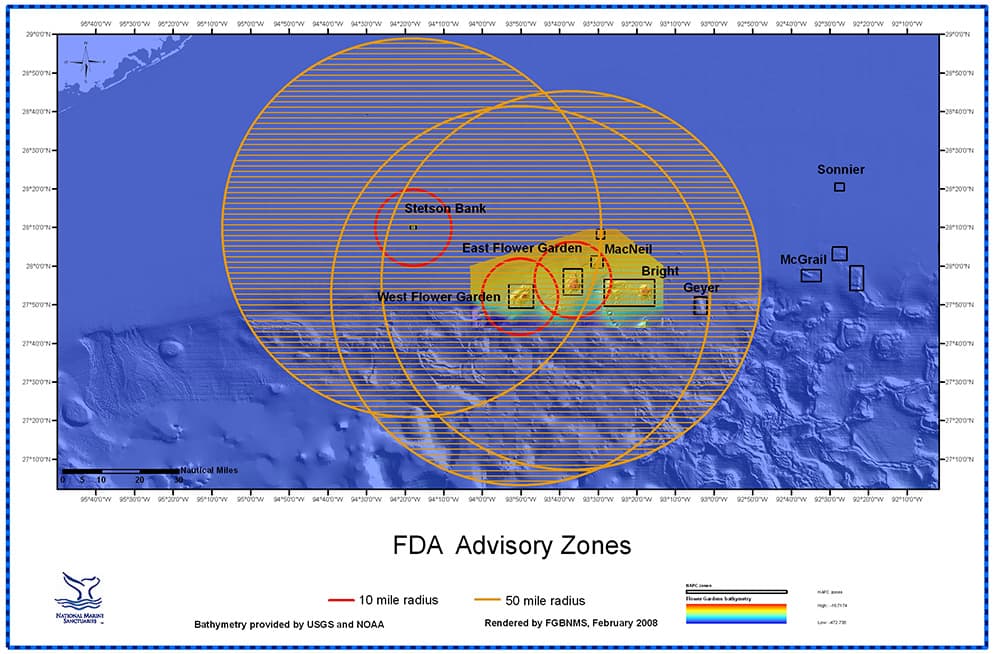
Ciguatera fish poisoning (CFP) is caused by ciguatoxins that are produced by microalgae in the genus Gambierdiscus. Fish that feed on these algae accumulate toxins in their flesh. These toxins then move up the food chain in a process known as bioaccumulation, where herbivorous fish pass the toxin onto carnivorous fish when consumed.
Eating fish that contain this toxin can lead to CFP and cause a range of symptoms over the next 6-24 hours. These include vomiting, diarrhea, abdominal pain, muscle cramps, headaches, profound fatigue, itching and tingling skin, and a reversal of hot and cold sensations. On a global scale, CFP is the main cause of non-bacterial illness associated with seafood consumption.

Ciguatera in the Sanctuary
While Flower Garden Banks National Marine Sanctuary (FGBNMS) does not have a history of harmful algal blooms, several naturally occurring diatom species in the sanctuary are known to cause CFP.
In May 2007, FGBNMS received notification from the Food and Drug Administration (FDA) regarding a confirmed report of CFP resulting from human consumption of a gag grouper caught in the sanctuary. In response to this issue, the National Oceanic and Atmospheric Administration (NOAA) collected and analyzed a sample of fish from the sanctuary and its immediate surroundings.
The sampling focused on large, carnivorous reef fish such as barracuda, hogfish, groupers, snappers, jacks, and mackerel since they were the most likely to have accumulated significant amounts of the ciguatera toxin. Overall, 31 fish representing 12 different species were tested.

Of the 31 fish sampled, four specimens (13% of fish sampled) were found to contain ciguatoxin above FDA-recommended levels: marbled grouper, great barracuda, sand tilefish, and scamp (pictured below). The tested fish were found at depths over 135 feet (41m) and were the likely source of ciguatoxins entering the food chain. These were also the deepest records for CFP-causing organisms reported globally and indicate that deeper habitats may be an unexpected source of toxins entering the food chain.
FDA Advisory
In 2008, this finding led the FDA to issue a letter of guidance to seafood processors recommending that they avoid purchasing large carnivorous reef fish caught in FGBNMS or within specific ranges around the sanctuary (see map below).

Sampling of fish has continued through a partnership with NOAA’s Southeast Area Monitoring and Assessment Program (SEAMAP) and NOAA’s National Center for Coastal and Ocean Science (NCCOS).
Continued Sampling
In 2013, 52 fish (barracuda, Warsaw grouper, greater amberjack, and vermillion snapper) were collected, and 48% had measurable ciguatoxin. Additionally, ten fish (19%) had concentrations high enough to cause illness.
In 2015, lionfish were sampled from East Flower Garden Bank and West Flower Garden Bank, but no ciguatoxin was found.
In 2021, hook and line sampling with SEAMAP took place at East and West Flower Garden Banks. Of the 50 fish analyzed, five fish (10%) had high enough ciguatoxin concentrations to cause sickness.
As noted above, select samples collected by partners have shown elevated levels of ciguatoxin, but there have been no reported cases of CFP since 2007.

